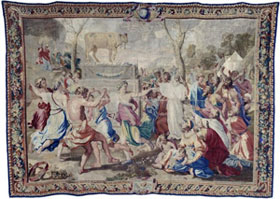Cartoon for the tapestry "The Golden Calf"

Le Veau d'Or
collection du Mobilier national
© L.Perquis
You are now in front of the cartoon for the tapestry of The Adoration of the Golden Calf which recreates a painting by Nicolas Poussin, painted between 1633 and 1637 for patron of the arts Amadeo del Pozzo, which hangs in London.
In this passage, Moses climbs Mount Sinai to receive from God the Tablets of the Law on which the 10 commandments will be written. When Moses goes back to his people to present them with the Tablets of the Law, a bitter disappointment awaits him. The people have made themselves a golden statue of a calf, an "idol", and are celebrating in honour of this new god. At the sight of this Adoration of a Golden Calf, Moses grows angry and throws down the tablets, smashing them.
Let’s look more closely at this work, produced by Pierre de Sève, probably before 1683.
Pierre de Sève was himself a significant player in the creation of the Moses tapestry. Employed at the Gobelins tapestry works as painter-cartoon maker, he was also responsible for running the drawing school. It was he who produced the three cartoons based on Poussin’s paintings for the following tapestries: Moses trampling the crown of the Pharaoh, which you saw on the ground floor, Moses Striking the Rock, immediately to the left of this cartoon, and The Golden Calf, which you are looking at now.
The "cartoon" plays a vital role in the making of a tapestry. It is in fact a transposition of the original painting, which is then used as a guide for the weaving. Unlike its name might suggest, the cartoon is not painted on cardboard (carton in French) but on a piece of canvas corresponding to the size of the future tapestry. The traditional technique of the Gobelins weavers required the cartoon to be cut into 5 strips.
The finished product that is the tapestry therefore derives directly from the compositional choices made at the cartoon stage, which is the base from which the weavers work.
The cartoon is used in a different way depending on the loom used, high warp or low warp. With a low-warp loom, it is placed beneath the two layers of even and odd warp threads that form the shed. It is therefore reproduced in reverse, with the work being done from the back. With a high-warp loom, the work is also done on the reverse side, but the drawing is not inverted because the cartoon, hung behind the weaver, is transferred in sections as he progresses by being traced directly onto the warp yarns.
The transposition of a painting into a tapestry requires some alterations to be made, because the weaving process is not always able to copy pictorial designs and effects. This is the reason why the cartoons differ from the original paintings.
